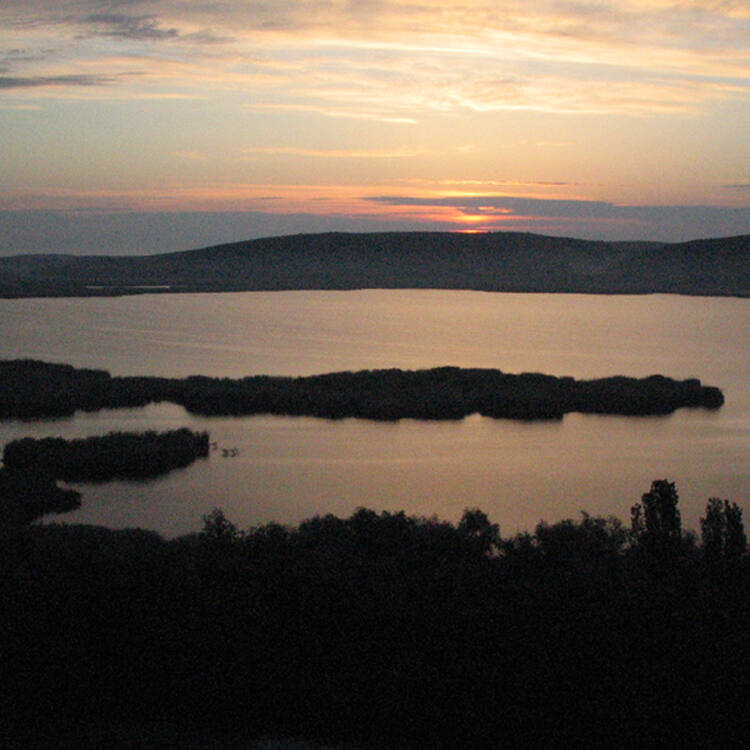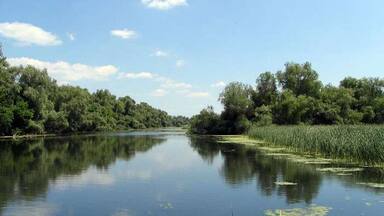Srebarna Nature Reserve
Srebarna Nature Reserve
The Srebarna Nature Reserve is a freshwater lake adjacent to the Danube and extending over 600 ha. It is the breeding ground of almost 100 species of birds, many of which are rare or endangered. Some 80 other bird species migrate and seek refuge there every winter. Among the most interesting bird species are the Dalmatian pelican, great egret, night heron, purple heron, glossy ibis and white spoonbill.
Description is available under license CC-BY-SA IGO 3.0
Réserve naturelle de Srébarna
La réserve naturelle de Srébarna est un lac d’eau douce adjacent au Danube qui s’étend sur plus de 600 ha. Il abrite près de 100 espèces d’oiseaux qui viennent s’y reproduire et dont beaucoup sont rares ou menacées. Quelque 80 autres espèces d’oiseaux s’y réfugient au cours de leur migration chaque hiver. Parmi les espèces d’oiseaux les plus intéressantes, on note le pélican dalmate, le bihoreau gris, l’ibis falcinelle et la spatule blanche.
Description is available under license CC-BY-SA IGO 3.0
محميّة سريبارنا الطبيعية
تتألف محميّة سريبارنا الطبيعية من بحيرة من المياه العذبة متاخمة لنهر الدانوب تمتّد على مساحة تفوق 600 هكتار. وتأوي حوالى 100 جنس من الطيور النادرة أو المهددة بالإنقراض بمعظمها والتي تلجأ إلى هذا المكان لتتكاثر. كما يجد 80 صنفاً آخر من الطيور ملاذاً آمناً له في هذه البحيرة خلال هجرته الشتائية. ومن أبرز أجناس الطيور الموجودة، البجع الدلماسي وغراب الليل الرمادي وأبو منجل والملاعقي الأبيض.
source: UNESCO/CPE
Description is available under license CC-BY-SA IGO 3.0
斯雷伯尔纳自然保护区
斯雷伯尔纳自然保护区是一处毗邻多瑙河的淡水湖,总面积超过600公顷。有约100种鸟类在这个保护区内生活繁衍,其中许多是稀有濒危鸟类,另外还有大约80种侯鸟每年到这里过冬。这里最重要的鸟类包括达尔马提亚鹈鹕、白鹭、夜苍鹭、紫苍鹭、朱鹭和白篦鹭。
source: UNESCO/CPE
Description is available under license CC-BY-SA IGO 3.0
Природный резерват Сребырна
Пресноводное озеро, лежащее вблизи русла Дуная, имеет площадь 600 га. Здесь гнездятся птицы почти 100 видов, многие из которых признаны редкими и исчезающими. Еще примерно 80 видов птиц составляют мигранты, прилетающие сюда на зимовку. Среди наиболее примечательных птиц – кудрявый пеликан, большая белая, рыжая и черная цапли, каравайка, колпица.
source: UNESCO/CPE
Description is available under license CC-BY-SA IGO 3.0
Reserva natural de Srebarna
La reserva natural de Srebarna está formada por un lago de agua dulce, adyacente al río Danubio, que se extiende por más de 600 hectáreas. Alberga unas 100 especies de aves que vienen aquí a reproducirse, muchas de las cuales son raras o se hallan en peligro de extinción. Otras 80 especies de aves hallan refugio en la reserva cada invierno, en la época de su migración. Entre las más interesantes cabe destacar el pelícano dálmata, la garza gris, el ibis morito y la espátula blanca.
source: UNESCO/CPE
Description is available under license CC-BY-SA IGO 3.0
スレバルナ自然保護区
source: NFUAJ
Natuurreservaat Srebarna
Het Natuurreservaat Srebarna bestaat uit een zoetwatermeer grenzend aan de Donau en strekt zich uit over een gebied van 600 hectare. Het reservaat is hoofdzakelijk opgericht om de rijke diversiteit aan wilde vogels te beschermen, die de helft van de Bulgaarse avifauna vertegenwoordigen. Het reservaat is de broedplaats van bijna 100 vogelsoorten, de meeste daarvan zijn zeldzaam of bedreigd. Voor ongeveer 80 andere migrerende vogelsoorten vormt het elke winter een schuilplek. Een aantal interessante vogelsoorten dat voorkomt in het gebied zijn de Dalmatische pelikaan, de grote zilverreiger, de nachtreiger, de purperreiger, de zwarte ibis en de witte lepelaar.
Source: unesco.nl
Outstanding Universal Value
Brief synthesis
Srebarna Nature Reserve protects a lake and wetland ecosystem of 638ha located near to the village of Srebarna on the west bank of the Danube River. The reserve includes the lake and the former agricultural lands north of the lake, a belt of forest plantations along the Danube, the island of Komluka and the aquatic area locked between the island and the riverbank.
Srebarna Nature Reserve is an important wetland on the Western Palaearctic bird migratory flyway. It provides nesting grounds for 99 species of birds and seasonal habitat to around 80 species of migratory birds. The property is surrounded by hills which provide a natural boundary and offer an ideal means for observing the waterfowl.
Criterion (x): Srebarna Nature Reserve protects an important example of a type of wetland that was widespread in Bulgaria in the past. It shelters a diversity of plant and animal species, which are increasingly threatened. The wetland is an important breeding, staging and wintering site for a large number of birds. Floating reedbed islands and flooded willow woodlands provide important bird breeding areas. In the lake's northern end the reedbeds gradually give way to wet meadows. In the north-western end of the lake and along the Danube there are belts of riverine forest with single old trees of White Willow.
The rich bird life supported by Srebarna Nature Reserve is the basis for its international significance. The property holds populations of birds that are considered critical to species survival. It hosts the only colony of Dalmatian Pelican in Bulgaria, as well as the largest breeding populations of four more globally threatened species: Pygmy Cormorant, Ferruginous Duck, White-tailed Eagle and Corncrake. Srebarna is also of European value importance in supporting Little Bittern Night Heron, Squacco Heron, Little Egret, Great White Egret, Purple Heron, Glossy lbis, Spoonbill and Ruddy Shelduck. Three species of terns also occur here. Globally threatened Pygmy Cormorant and Red-breasted Goose winter in the Reserve, and the wintering populations of White-fronted Goose, Greylag Goose and Fieldfare are also notable.
In total the property provides critical habitat that supports 173 bird species, 78 species of which are of European conservation concern, and nine being listed as globally threatened.
Integrity
The property includes the largest lake left after drainage of the marshy zone along the Danube and was connected to the river until a dyke was built in 1949. Its current situation is therefore not completely natural and is maintained by water management measures. In 1994 a channel was constructed between the lake and the Danube river in order to ensure the annual flow of Danube waters into the lake during the spring months. The Reserve is a strictly protected area, and only carefully-controlled scientific research, and conservation management activities are allowed to take place within it. The site is relatively small, and only if other areas are also protected, in the region and on bird migration routes, can the key species of Srebarna Nature Reserve be expected to survive.
The property is protected by a 673 ha buffer zone which was created in 2008. This consists of a portion of the Srebarna Nature Reserve that is not part of the World Heritage property and 419 ha of land surrounding the Srebarna Nature Reserve, which is located within an adjacent protected area known as Pelikanite. The aim of this buffer zone is to prevent and reduce negative human impacts on the reserve.
Protection and management requirements
Srebarna Lake was the first wetland in Bulgaria to receive legal protection status and also the first to achieve international recognition. The lake was designated as reserve in 1948 to protect the diversity of birds it hosts. According to the 1998 law dealing with protected areas in Bulgaria, the property is classified as a “Managed Reserve", being exclusively State property. Management and control are carried out by the Ministry of Environment and Water and its regional departments. The reserve falls under the jurisdiction of the Regional Inspectorate of environment and water for the town of Russe. Besides its inclusion on the World Heritage List, Srebarna Lake is also protected as a Wetland of International Importance under the Ramsar Convention and as a UNESCO Biosphere Reserve. In 1989 the lake was designated as an lmportant Bird Area by BirdLife International. Its values are also recognised and protected at the European level. The property is also included in two Natura 2000 sites: the Srebarna Special Protection Area and Ludogorie-Srebarna Special Area of Conservation.
The property requires active management, and a management plan needs to be maintained and updated to guide this work. Keys objectives of the management plan are conservation management for the protection of its breeding bird populations, and the continued function of the property as a stopover site for migratory birds. Specific regimes are in place for a number of different zones in the reserve, according to their conservation value. Key management requirements for the lake are to maintain and restore its water system to as natural a state as possible. Vegetation management is also needed to optimize the conservation value of the property to birds. Control of human use and the active prevention of poaching and illegal fishing are also required on an ongoing basis. Monitoring of activities to ensure management plan implementation is required in relation to the achievement of clear targets that should be defined and updated in the management plan.
Protection of the values of the property also relies on measures outside its boundaries. The buffer zone of the property is important in preventing the introduction of non-local plant or animal species, pollution from domestic, industrial or other types of waste, hunting during bird nesting and breeding periods, burning of reeds, and other activities that could disturb the nesting and breeding bird colonies. Some of these issues also require measures beyond the defined buffer zone of the property. The linkage of the property with other reserves on the Romanian side of the Danube, and within the wider Western Palaearctic migratory flyway, would also enhance its integrity and the protection of its natural values.



